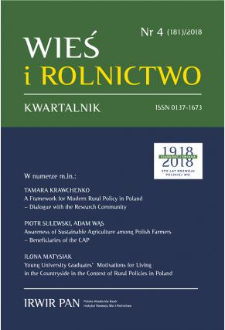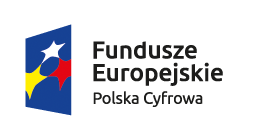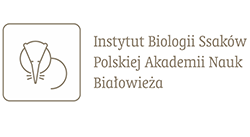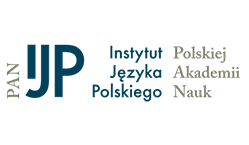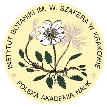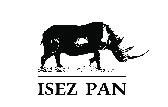- Wyszukaj w całym Repozytorium
- Piśmiennictwo i mapy
- Archeologia
- Baza Młynów
- Nauki przyrodnicze
Wyszukiwanie zaawansowane
Wyszukiwanie zaawansowane
Wyszukiwanie zaawansowane
Wyszukiwanie zaawansowane
Wyszukiwanie zaawansowane

Obiekt
Tytuł: Awareness of Sustainable Agriculture among Polish Farmers – Beneficiaries of the CAP
Wydawca:
Instytut Rozwoju Wsi i Rolnictwa Polskiej Akademii Nauk
Miejsce wydania:
Typ obiektu:
Abstrakt:
The main objective of the study was an assessment of the awareness and actions undertaken by farmers in the selected fields of farm activity from the sustainability point of view. The research covered a representative sample of 600 farmers participating in the Polish Farm Accountancy Data Network (FADN). The data from the FADN database were supplied by the information from interviews with farmers. The sustainability indicators were analysed with regard to the amount and type of subsidies received. The sample was divided regarding type and amount of support. The results showed that, on average, the highest sustainability indicators were in farms receiving support under agri-environmental programmes and located in LFAs (less favoured areas), while the lowest were usually in other farms in the LFAs. The analysis of differences between farms categorised according to the total value of subsidies received, found that on average farms with the highest absolute level of support achieved higher sustainability parameters in all dimensions. Based on the results it can be concluded that higher and more varied subsidies to farmers are positively correlated with sustainability of their farms.
Bibliografia:
Anand S., Sen A. (1994). Sustainable Human Development: Concepts and Priorities. Human Development Report Office (HDRO), United Nations Development Programme (UNDP), Human Development Occasional Papers (1992–2007).
Bardy R., Rubens A., Massaro M. (2015). The systemic dimension of sustainable devel- opment in developing countries. Journal of Organisational Transformation & Social Change, 12 (1), 22–41.
![]()
Barreiro-Hurle J., Espinosa-Goded M., Dupraz P. (2010). Does intensity of change matter? Factors affecting adoption of agri-environmental schemes in Spain. Journal of Environmental Planning and Management, 53 (7), 891–905.
![]()
Burton R.J.F., Paragahawewa U.H. (2011). Creating culturally sustainable agrienvironmental schemes. Journal of Rural Studies, 27, 95–104.
![]()
Ciegis R., Ramanauskiene J., Martinkus B. (2009). The concept of sustainable development and its use for sustainability scenarios. Inzinerine Ekonomika – Engineering Economics, 62 (2), 28–37.
Cochran W.G. (1977). Sampling Techniques. New York, Chichester, Brisbane, Toronto, Singapore: John Wiley & Sons.
Defrancesco E., Gatto P., Runge F., Trestini S. (2008). Factors affecting farmers’ participation in agri-environmental measures: A northern Italian perspective. Journal of Agricultural Economics, 59 (1), 114–131.
![]()
Duer I., Fotyma M., Madej A. (2002). Kodeks Dobrej Praktyki Rolniczej. Warsaw: Ministerstwo Rolnictwa i Rozwoju Wsi, Ministerstwo Środowiska.
Dumanski J., Terry E., Byerlee D., Pieri C. (1998). Performance Indicators for Sustainable Agriculture. Discussion Note. Washington, D.C.: The World Bank.
Ecorys (2017). Modernizing and simplifying the CAP: Summary of the results of the public consultation. Brussels: European Commission – DG for Agriculture and Rural Development.
Emas R. (2015). The Concept of Sustainable Development: Definition and Defining Principals. Brief for GSDR.
EC (European Commission) (2017). Communication from the Commission to the European Parliament, the Council, the European Economic and Social Committee and the Committee of the Regions, the Future of Food and Farming. COM(2017)713 final. Brussels.
FADN (Farm Accountancy Data Network) (2008). Plan of sampling for Polish FADN. Warsaw: Instytut Ekonomiki Rolnictwa i Gospodarki Żywnościowej – Państwowy Instytut Ba- dawczy.
Fleury P., Seres C., Dobremez L., Nettier B., Pauthenet Y. (2015). “Flowering Meadows”. A result-oriented agri-environmental measure: Technical and value changes in favour of biodiversity. Land Use Policy, 46, 103–114.
![]()
Green G.P., Heffernan W.D. (1987). Soil erosion and perception of the problem. Journal of Rural Studies, 3 (2), 151–157.
![]()
Greiner R., Patterson L., Miller O. (2009). Motivations, risk perceptions and adoption of conservation practices by farmers. Agricultural Systems, 99 (2-3), 86–104.
![]()
Hansen J.W. (1996). Is agricultural sustainability a useful concept? Agricultural Systems, 50, 117–143.
![]()
Hayati D. (2017). A Literature Review on Frameworks and Methods for Measuring and Monitoring Sustainable Agriculture. Technical Report, 22. Rome: Global Strategy.
Herzele A., Gobin A., Van Gossum P., Acosta L., Waas T., Dendoncker N., de Frahan
B. (2013). Effort for money? Farmers’ rationale for participation in agri-environment measures with different implementation complexity. Journal of Environmental Management, 131, 110–120.
![]()
Ikerd J. (1997). Understanding and managing the multi-dimensions of sustainable agriculture. Paper presented at the Southern Region Sustainable Agriculture Professional Development Program Workshop, SARE Regional Training Consortium, Gainesville, FL, January 15th, 1997.
Kalton G. (1983). Introduction to Survey Sampling. Newbury Park, London, New Delhi: Sage Publications.
![]()
Kiełbasa B., Pietrzak S., Ulén B., Drangert J.O., Tonderski K. (2018). Sustainable agriculture: The study on farmers’ perception and practices regarding nutrient management and limiting losses. Journal of Water and Land Development, 36 (1–3), 67–75.
![]()
Kington E.A., Pannell D.J. (2003). Dryland salinity in the Upper Kent River catchment of Western Australia: Farmer perception and practices. Australian Journal of Experimental Agriculture, 203 (43), 19–28.
![]()
Krasowicz S., Kuś J. (2010). Kierunki zmian w produkcji rolniczej w Polsce do roku 2020: Próba prognozy. Zagadnienia Ekonomiki Rolnej, 3 (324), 5–18.
Lastro-Bravo X.B., Hubbard M.C., Garrod G.D., Tolon-Becerra A. (2015) What drives farmers’ participation in EU agri-environmental schemes? Results from a qualitative meta-analysis. Environmental Science & Policy, 54, 1–9.
![]()
Latruffe L., Diazabakana A., Bockstaller Ch., Desjeux Y., Finn J., Kelly E., Ryan M., Uthes S. (2016). Measurement of sustainability in agriculture: A review of indicators. Studies in Agricultural Economics, 118 (3), 123–130.
![]()
Long G. (2015). The idea of universality in the sustainable development goals. Ethics & International Affairs, 29 (2), 203–222.
![]()
Majewski E. (2001). Jakość zarzadzania w gospodarstwach rolniczych w Polsce w świetle badań. Warsaw: Wydawnictwo Szkoły Głównej Gospodarstwa Wiejskiego.
Majewski E. (2002). Ekonomiczno-organizacyjne uwarunkowania rozwoju Systemu Integrowanej Produkcji Rolniczej (SIPR) w Polsce. Warsaw: Wydawnictwo Szkoły Głównej Gospodarstwa Wiejskiego.
Majewski E. (2008). Trwały rozwój i trwałe rolnictwo: Teoria a praktyka gospodarstw rolniczych. Warsaw: Wydawnictwo Szkoły Głównej Gospodarstwa Wiejskiego.
Majewski E., Bednarek A., Bagel M., Hurej M., Łabętowicz J., Radecki A., Skomiał J., Straszewski S. (1997). System Integrowanej Produkcji Rolniczej: Wytyczne i instrukcja wdrożeniowa. Warsaw: Wydawnictwo Szkoły Głównej Gospodarstwa Wiejskiego.
McCracken M.E., Woodcock B.A., Lobley M., Pywell R.F., Saratsi E., Swetman R.D., Mortimer S.R., Harris S.J., Winter M., Hinsley S., Bullock J.M. (2015). Social and ecological drivers of success in agri-environment schemes: The roles of farmers and environmental context. Journal of Applied Ecology, 52 (3), 696–705.
![]()
Morris J., Mills J., Crawford I.M. (2000). Promoting farmer uptake of agri-environment schemes: the countryside stewardship arable options scheme. Land Use Policy, 17 (3), 241–254.
![]()
Neyman J. (1934). On the two different aspects of the representative method: The method of stratified sampling and the method of purposive selection. Journal of the Royal Statistical Society, 97(4), 558–625.
![]()
OECD (Organisation for Economic Co-operation and Development) (2018). OECD Rural Policy Reviews: Poland 2018. OECD Rural Policy Reviews. Paris: OECD Publishing.
Okumah M., Martin-Ortega J., Novo P. (2018). Effects of awareness on farmers’ compliance with diffuse pollution mitigation measures: A conditional process modeling. Land Use Policy, 76, 36–45.
![]()
Pannell D.J., Schilizzi S. (1998). Sustainable agriculture: A matter of ecology, equity, economic efficiency or expedience? Journal of Sustainable Agriculture, 13 (4), 57–66.
![]()
Pretty J. (1996). Regenerating agriculture, policies and practices for sustainability and selfreliance. Washington, D.C.: National Academy Press.
Pretty J. (2008). Agricultural sustainability: concepts, principles and evidence. Philosophical Transactions of the Royal Society B: Biological Sciences, 363, 447–465.
![]()
Rigby D., Caceres D. (2001). Organic farming and the sustainability of agricultural system. Agricultural Systems, 68 (1), 21–40.
![]()
Ruto E., Garrod G. (2009). Investigating farmers’ preferences for the design of agri-environmental schemes: A choice experiment approach. Journal of Environmental Planning and Management, 52 (5), 631–647.
![]()
Sabiha N., Salim R., Rahman S., Rola-Rubzen M.F. (2016). Measuring environmental sustainability in agriculture: A composite environmental impact index approach. Journal of Environmental Management, 166, 84–93.
![]()
Sadok W., Angevin F., Bergez J., Bockstaller C., Colomb B., Guichard L., Reau R., Dore T. (2008). Ex ante assessment of the sustainability of alternative cropping systems: Implications for using multi-criteria decision-aid methods. A review. Agronomy for Sustainable Development, 28 (1), 163–174.
![]()
Spindler E. (2013). The history of sustainability, the origins and effects of a popular concept. In: I. Jenkins, R. Schröder (eds.), Sustainability in Tourism (pp. 9–31). Wiesbaden: Springer Gabler.
![]()
Stanny M., Czarnecki A. (2011). Zrównoważony rozwój obszarów wiejskich Zielonych Płuc Polski: Próba analizy empirycznej. Warsaw: Instytut Rozwoju Wsi i Rolnictwa Polskiej Akademii Nauk.
Tatlıdil F.F., Boz I., Tatlidil H. (2009). Farmers’ perception of sustainable agriculture and its determinants: A case study in Kahramanmaras province of Turkey. Environment, Development and Sustainability, 11 (6), 1091–1106.
![]()
UNEP (United Nations Environment Programme), UNHR (United Nations Human Rights) (2015). Universality in the Post 2015 Sustainable Development Agenda. UNEP Post 2015, Note 9. OHCHR Human Rights and Post 2015.
UN (United Nations) (2015). Resolution adopted by the General Assembly on 25 Septem- ber 2015. Transforming our world: the 2030 Agenda for Sustainable Development. A/RES/70/1. Washington D.C.: United Nations General Assembly.
Werf van der H.M.G., Petit J. (2002). Evaluation of the environmental impact of agriculture at the farm level: a comparison and analysis of 12 indicator-based methods. Agriculture, Ecosystems and Environment, 93 (1-3), 131–145.
![]()
Wilson G.A., Hart K. (2000). Financial imperative or conservation concern? EU farmers’ motivations for participation in voluntary agri-environmental schemes. Environment and Planning A: Economy and Space, 32 (12), 2161–2185.
![]()
Wilson G.A., Hart K. (2002). Farmer participation in agri-environmental schemes: Towards conservation oriented thinking? Sociologia Ruralis, 41 (2), 254–274.
![]()
WCED (World Commission on Environment and Development) (1987). Our Common Future. Oxford: Oxford University Press.
Zhen L., Routrayb J., Zoebischc M., Chend G., Xiea G., Chenga S. (2005). Three dimensions of sustainability of farming practices in the North China Plain: A case study from Ningjin County of Shandong Province, PR China. Agriculture, Ecosystems and Environment, 105, 507–522.
![]()
Czasopismo/Seria/cykl:
Zeszyt:
Strona pocz.:
Strona końc.:
Identyfikator zasobu:
oai:rcin.org.pl:243587 ; doi:10.53098/wir042018/03 ; 0137-1673 (print); 2657-5213 (on-line)
Źródło:
Język:
Język streszczenia:
Prawa:
Creative Commons Attribution BY 4.0 license
Zasady wykorzystania:
Digitalizacja:
Institute of Rural and Agricultural Development of the Polish Academy of Sciences
Lokalizacja oryginału:
Library of the Institute of Rural and Agriculture Development of the PAS
Dofinansowane ze środków:
Dostęp:
Kolekcje, do których przypisany jest obiekt:
- Repozytorium Cyfrowe Instytutów Naukowych > Piśmiennictwo > Czasopisma/Artykuły
- Repozytorium Cyfrowe Instytutów Naukowych > Kolekcje Partnerów > Instytut Rozwoju Wsi i Rolnictwa PAN > Zbiory biblioteczne
Data ostatniej modyfikacji:
13 mar 2025
Data dodania obiektu:
15 sty 2025
Liczba pobrań / odtworzeń:
0
Wszystkie dostępne wersje tego obiektu:
https://rcin.org.pl./publication/280689
Wyświetl opis w formacie RDF:
Wyświetl opis w formacie RDFa:
Wyświetl opis w formacie OAI-PMH:
| Nazwa wydania | Data |
|---|---|
| Świadomość trwałego rolnictwa wśród polskich rolników – beneficjentów Wspólnej Polityki Rolnej | 13 mar 2025 |
Obiekty Podobne
Littke, Helene Rauhut, Daniel
Stępień, Sebastian Smędzik-Ambroży, Katarzyna Guth, Marta
Czyżewski, Bazyli Matuszczak, Anna Przekota, Grzegorz
Kutkowska, Barbara Hasiński, Władysław
Adamowicz, Mieczysław
Sokołowska, Stanisława Szwiec, Paweł
Adamowicz, Mieczysław

 INSTYTUT ARCHEOLOGII I ETNOLOGII POLSKIEJ AKADEMII NAUK
INSTYTUT ARCHEOLOGII I ETNOLOGII POLSKIEJ AKADEMII NAUK
 INSTYTUT BADAŃ LITERACKICH POLSKIEJ AKADEMII NAUK
INSTYTUT BADAŃ LITERACKICH POLSKIEJ AKADEMII NAUK
 INSTYTUT BADAWCZY LEŚNICTWA
INSTYTUT BADAWCZY LEŚNICTWA
 INSTYTUT BIOLOGII DOŚWIADCZALNEJ IM. MARCELEGO NENCKIEGO POLSKIEJ AKADEMII NAUK
INSTYTUT BIOLOGII DOŚWIADCZALNEJ IM. MARCELEGO NENCKIEGO POLSKIEJ AKADEMII NAUK
 INSTYTUT BIOLOGII SSAKÓW POLSKIEJ AKADEMII NAUK
INSTYTUT BIOLOGII SSAKÓW POLSKIEJ AKADEMII NAUK
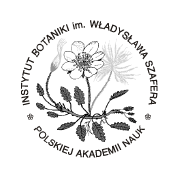 INSTYTUT CHEMII FIZYCZNEJ PAN
INSTYTUT CHEMII FIZYCZNEJ PAN
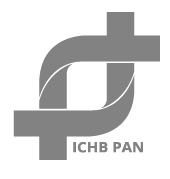 INSTYTUT CHEMII ORGANICZNEJ PAN
INSTYTUT CHEMII ORGANICZNEJ PAN
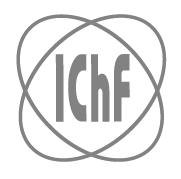 INSTYTUT FILOZOFII I SOCJOLOGII PAN
INSTYTUT FILOZOFII I SOCJOLOGII PAN
 INSTYTUT GEOGRAFII I PRZESTRZENNEGO ZAGOSPODAROWANIA PAN
INSTYTUT GEOGRAFII I PRZESTRZENNEGO ZAGOSPODAROWANIA PAN
 INSTYTUT HISTORII im. TADEUSZA MANTEUFFLA POLSKIEJ AKADEMII NAUK
INSTYTUT HISTORII im. TADEUSZA MANTEUFFLA POLSKIEJ AKADEMII NAUK
 INSTYTUT JĘZYKA POLSKIEGO POLSKIEJ AKADEMII NAUK
INSTYTUT JĘZYKA POLSKIEGO POLSKIEJ AKADEMII NAUK
 INSTYTUT MATEMATYCZNY PAN
INSTYTUT MATEMATYCZNY PAN
 INSTYTUT MEDYCYNY DOŚWIADCZALNEJ I KLINICZNEJ IM.MIROSŁAWA MOSSAKOWSKIEGO POLSKIEJ AKADEMII NAUK
INSTYTUT MEDYCYNY DOŚWIADCZALNEJ I KLINICZNEJ IM.MIROSŁAWA MOSSAKOWSKIEGO POLSKIEJ AKADEMII NAUK
 INSTYTUT PODSTAWOWYCH PROBLEMÓW TECHNIKI PAN
INSTYTUT PODSTAWOWYCH PROBLEMÓW TECHNIKI PAN
 INSTYTUT SLAWISTYKI PAN
INSTYTUT SLAWISTYKI PAN
 SIEĆ BADAWCZA ŁUKASIEWICZ - INSTYTUT TECHNOLOGII MATERIAŁÓW ELEKTRONICZNYCH
SIEĆ BADAWCZA ŁUKASIEWICZ - INSTYTUT TECHNOLOGII MATERIAŁÓW ELEKTRONICZNYCH
 MUZEUM I INSTYTUT ZOOLOGII POLSKIEJ AKADEMII NAUK
MUZEUM I INSTYTUT ZOOLOGII POLSKIEJ AKADEMII NAUK
 INSTYTUT BADAŃ SYSTEMOWYCH PAN
INSTYTUT BADAŃ SYSTEMOWYCH PAN
 INSTYTUT BOTANIKI IM. WŁADYSŁAWA SZAFERA POLSKIEJ AKADEMII NAUK
INSTYTUT BOTANIKI IM. WŁADYSŁAWA SZAFERA POLSKIEJ AKADEMII NAUK
